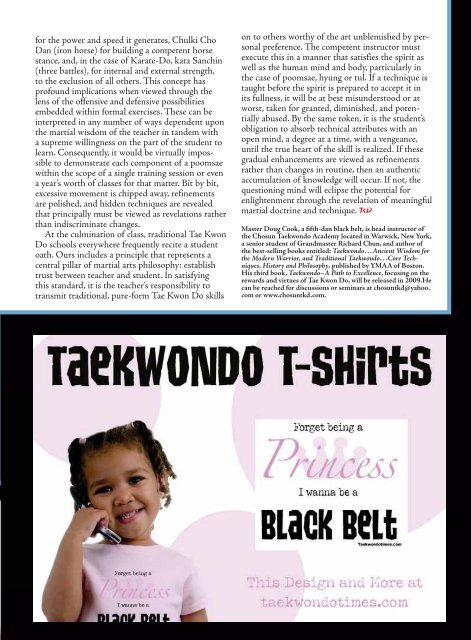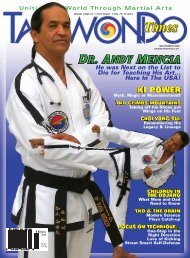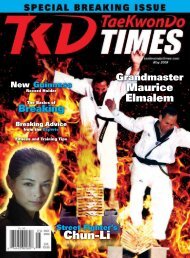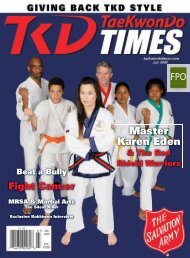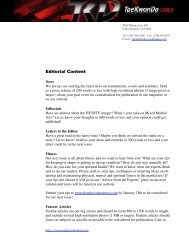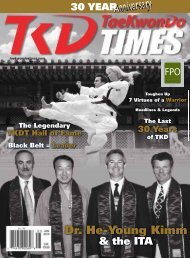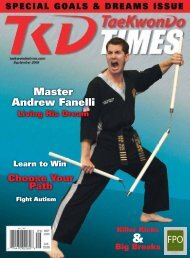Grandmaster Ken MacKenzie - Taekwondo Times
Grandmaster Ken MacKenzie - Taekwondo Times
Grandmaster Ken MacKenzie - Taekwondo Times
You also want an ePaper? Increase the reach of your titles
YUMPU automatically turns print PDFs into web optimized ePapers that Google loves.
for the power and speed it generates, Chulki Cho<br />
Dan (iron horse) for building a competent horse<br />
stance, and, in the case of Karate-Do, kata Sanchin<br />
(three battles), for internal and external strength,<br />
to the exclusion of all others. This concept has<br />
profound implications when viewed through the<br />
lens of the offensive and defensive possibilities<br />
embedded within formal exercises. These can be<br />
interpreted in any number of ways dependent upon<br />
the martial wisdom of the teacher in tandem with<br />
a supreme willingness on the part of the student to<br />
learn. Consequently, it would be virtually impossible<br />
to demonstrate each component of a poomsae<br />
within the scope of a single training session or even<br />
a year’s worth of classes for that matter. Bit by bit,<br />
excessive movement is chipped away, refinements<br />
are polished, and hidden techniques are revealed<br />
that principally must be viewed as revelations rather<br />
than indiscriminate changes.<br />
At the culmination of class, traditional Tae Kwon<br />
Do schools everywhere frequently recite a student<br />
oath. Ours includes a principle that represents a<br />
central pillar of martial arts philosophy: establish<br />
trust between teacher and student. In satisfying<br />
this standard, it is the teacher’s responsibility to<br />
transmit traditional, pure-form Tae Kwon Do skills<br />
on to others worthy of the art unblemished by personal<br />
preference. The competent instructor must<br />
execute this in a manner that satisfies the spirit as<br />
well as the human mind and body, particularly in<br />
the case of poomsae, hyung or tul. If a technique is<br />
taught before the spirit is prepared to accept it in<br />
its fullness, it will be at best misunderstood or at<br />
worst, taken for granted, diminished, and potentially<br />
abused. By the same token, it is the student’s<br />
obligation to absorb technical attributes with an<br />
open mind, a degree at a time, with a vengeance,<br />
until the true heart of the skill is realized. If these<br />
gradual enhancements are viewed as refinements<br />
rather than changes in routine, then an authentic<br />
accumulation of knowledge will occur. If not, the<br />
questioning mind will eclipse the potential for<br />
enlightenment through the revelation of meaningful<br />
martial doctrine and technique.<br />
Master Doug Cook, a fifth-dan black belt, is head instructor of<br />
the Chosun <strong>Taekwondo</strong> Academy located in Warwick, New York,<br />
a senior student of <strong>Grandmaster</strong> Richard Chun, and author of<br />
the best-selling books entitled: <strong>Taekwondo</strong>…Ancient Wisdom for<br />
the Modern Warrior, and Traditional <strong>Taekwondo</strong>…Core Techniques,<br />
History and Philosophy, published by YMAA of Boston.<br />
His third book, <strong>Taekwondo</strong>–A Path to Excellence, focusing on the<br />
rewards and virtues of Tae Kwon Do, will be released in 2009.He<br />
can be reached for discussions or seminars at chosuntkd@yahoo.<br />
com or www.chosuntkd.com.


